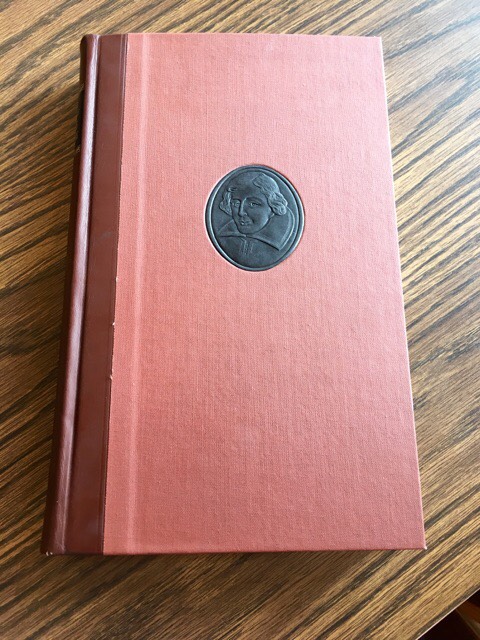Shakin' it up with Shax
The item we chose to study was The Poems of William Shakespeare, edited and introduced by Peter Alexander and illustrated with wood carvings by Agnes Miller Parker. The book was designed by John Dreyfus and printed by Brooke Crutchley at the University Printing House in Cambridge in 1967. This book is signed by the illustrator and is a Cambridge limited edition, copy 704 of only 1500 copies printed. The contents include the following: a dedication to Henry Wriothesley, preface to Venus and Adonis, Venus and Adonis, preface to The Rape of Lucrece, The Rape of Lucrece, preface to the Sonnets and A Lover’s Complaint, the Sonnets, A Lover’s Complaint, preface to The Passionate Pilgrim and The Phoenix and Turtle, The Passionate Pilgrim, The Phoenix and Turtle, and a glossary.
The book is relatively lightweight compared to its size, which is slightly longer and less wide than a standard sheet of paper and about an inch and a half thick. The book is simple, and the cover is made of rough, mahogany-colored cloth and bound with a brown, pleather spine. There is no title on the front cover, only a small, oval-shaped wood carving of William Shakespeare. The title, The Poems of William Shakespeare, is printed on the spine in simple gold script. The plainness of the book exists to not draw attention away from the contents within. The edges of the pages are stained to match the mahogany cover. The staining is shiny and appeals to more wealthy patrons, who would not be drawn to the plain, simple cover. The pages themselves are relatively thick with wide margins, and the 12-14 point font is slightly raised off the page, a characteristic of offset printing, which was popular when the book was published in 1967. The first couple of introductory pages in the book contain simple, black and white illustrations of Shakespeare or other objects relative to the contents of the book. The majority of the rest of the illustrations are found in the Sonnets rather than in the individual poems. There is an extensive glossary in the back of the book to assist readers in understanding Shakespeare’s language.


Our interpretation of our Shakespearean literature took the form of a poster for a poetry slam. We felt that a poetry slam would be the ideal representation of Shakespeare’s work in the Globe. Much like the theater during Shakespeare’s time, slam poetry gives the audience the ability to feel like part of the performance, much like Shakespeare’s dirty jokes were directed at the general public, slam poetry allows an artist to direct a particular work or idea at an audience. Our poster also helps to modernize the illustrations seen in our work, which is so important because the illustrations are important in understanding the quality of this book therefore a visual representation of this art work showcases its cost. Both the idea behind a slam poetry competition, and the physical representation of this idea, the poster, depict this work in such a way as to increase its relevance to modern day audiences.
Also, we felt that it was necessary to include Ovid in the project because Shakespeare drew a lot of ideas from Ovid's work & Ovid inspired Shakespeare. Shakespeare's poem Venus & Adonis contains many similarities to Ovid's poems collective called "Amores". Shakespeare’s narrative poem “The Rape of Luerece” was a poem about the rape of Lucretia through Ovid’s “Fasti”. Shakespeare was especially fond of Ovid's popular series known as "Metamorphoses". Several of Shakespeare's works were writing with what could be considered the "ovidian element". The ovidian element is Shakespeare's use of Ovid's work as a reference or taking bits of information from Ovid's work & using it in his own works. Because Shakespeare showed fondness in Ovid & because Ovid was such a big source of inspiration for Shakespeare it seemed necessary to include Ovid in the creative interpretation. An ode to Ovid would be a way to pay homage to Ovid & to acknowledge him for providing inspiration to one of the greatest poems of all time.